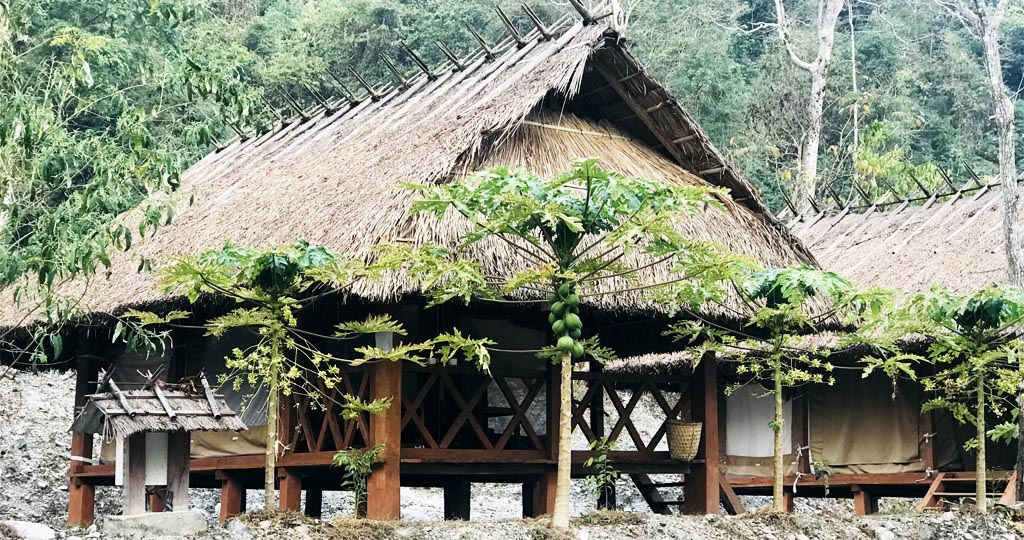Zhemgang – Bhutan’s Wildest & Worthiest Escape
Boasting of 33 types of mammals, 235 species of birds, 207 different kinds of butterflies, over 60 moth species, 350 varieties of wild flowers excluding 93 different orchids, Zhemgang is buzzing with flora, fauna and wildlife, not to mention state-of-the-art jungle and eco lodges.

There’s no refuting that mass tourism is a serious problem the world over.
Countless exotic destinations are buckling under the weight of their own popularity, as they struggle to maintain the pristine landscapes and conserve wildlife.
Likewise, there are also many destinations that prioritize ecotourism and conservation and minimize their environmental footprint. These places excel at offering travelers an opportunity to support the natural environment and preserve it for future generations to enjoy. Zhemgang is one such destination.
Surrounded by the Royal Manas National Park, the Jigme Singye National Park and the Phrumsengla National Park, Zhemgang is a haven for bird-watchers, nature lovers, hikers, and wildlife photographers alike. 90% of the biological corridors connecting the three parks fall inside Zhemgang. Suffice to say the district has almost 95% forest cover, the highest in the kingdom.

Zhemgang is truly is a nature lover’s paradise. And here’s why.
The district boasts of the highest number of tigers with a density of three tigers per 100 square kilometer. It has the second largest population of White-bellied Herons outside the Mangdechhu and Drangmechhu basins. The Golden Langur that is endemic to Bhutan is also found throughout the district. Birdwatchers will have a field day there as well, and travelers can stay at one of the campsites within the Royal Manas National Park or one of the many eco-lodges that can be found throughout the district.
Divided into three regions of upper Kheng, middle Kheng and Lower Kheng, the inhabitants of the region are mostly subsistence farmers relying on their agricultural produce to make a living. And while cash crops like orange, cardamom and potatoes help the locals generate extra income, they also rely heavily on bamboo crafting and bamboo products as a source of livelihood.
The lower region of Zhemgang bordering the state of Assam in India falls within the jurisdiction of the Royal Manas National Park – Bhutan’s oldest protected area since the early 1960s. This park shares its boundaries with the Manas National Park in India – a UNESCO World Heritage Site and Tiger Reserve.
As such, given its significance, Zhemgang has always been a sought after destination for tourists, especially high-end visitors. In the 1990s, however, guests were restricted from visiting the Royal Manas National Park due to insurgency problems along the trans-boundary until 2010, when the restrictions were lifted.
Another interesting fact is that the region is the first in Bhutan to use the river as a mode of transportation. Some of the wooden boats from the early 1960s are still in use today. In 2012, the River Guides of Panbang was formed by local youths to revitalize the legacy of journeying through the river. It is indeed a region with immense tourism potential. And, capitalizing on that, ecotourism took off in Zhemgang after 2010.
Ever since, eco lodges have mushroomed in areas like Gomphu, Pantang and Panbang. Initially, these lodges were developed by the Royal Manas National Park in collaboration with other agencies but, now, they have been handed over to the respective local communities.

Other popular stopovers for tourists and locals alike are Buli Tsho (Lake) and Duenmang Tshachu (hot spring). The Duenmang hot spring is touted as having healing properties and so people from near and afar throng to soak their illnesses away. For those who wish to spend the night or a few days in Buli and Duenmang, there are homestays certified by the Tourism Council of Bhutan. We are sure you will agree that there is no better way to soak in a culture other than mingling with the locals and experiencing their way of life.

